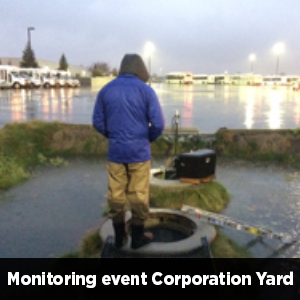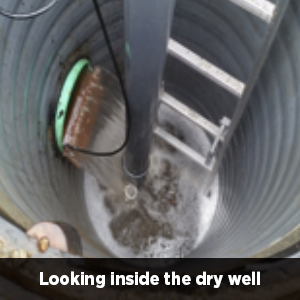Project Findings
Results of the project showed that with rare exception, none of the 200+ contaminants that were analyzed were detected in stormwater or groundwater. Specifically, volatile and semi-volatile organics were rarely detected. Polycyclic aromatic hydrocarbons (PAHs) were never detected in water, and there was a single detection of an herbicide in groundwater during the entire project. The class of contaminants that were regularly detected in stormwater were metals and pyrethroid pesticides. At the Corporation Yard, the concentration of aluminum in influent stormwater exceeded the Maximum Contaminant Level (MCL) by three-fold. Vegetated pretreatment reduced the concentration from 3 mg/L to 1 mg/L. Although the median concentration of aluminum in groundwater was below the reporting limit, it was occasionally quantifiable. However, the fact that there were no differences in concentration between the upgradient and downgradient wells suggests that runoff passing through the dry well was not the source of this metals. One dimensional vadose zone modeling suggested that even using a worst-case scenario, quantifiable concentrations of aluminum would not reach the vadose zone within the modeling timeframe of 3,000 years. A similar pattern of detections in stormwater was observed for a number of pyrethroid pesticides, including bifenthrin, at the water quality basin. However, none was detected in groundwater. Vadose zone modeling suggested that most metals and hydrophobic pesticides would not reach the water table at quantifiable levels within the modeling timeframe.

In contrast to metals and organics, a few class of contaminants were detected at elevated levels in groundwater. At both sites, nitrate concentrations exceeded the MCL in both upgradient and downgradient water table wells with low levels in stormwater. This pattern can be explained by long term leaching of nitrate out of the soil related to the historic agricultural uses of the land. A handful of detections of coliform bacteria was also measured in groundwater at the water quality basin, but these appear to be linked to infiltration through the entire water quality basin, not the dry well.
While fate and transport modeling did not suggest a risk to groundwater quality from any of the contaminants measured in this project, analysis was also performed on water soluble pesticides such as imidacloprid. In contrast to hydrophobic pollutants, water soluble pesticides could pass quickly through the vadose zone. Additional research on potential risks linked to neonicotinoids and fipronil is recommended.

In addition to investigating potential effects on groundwater quality, estimates of the effectiveness of vegetated pretreatment were made. There was a 50-65% reduction in total suspended solid (TSS) concentration as it passed through the grassy swale or water quality basin. If the sedimentation well had been functioning properly, the removal efficiency would have likely been greater.
Stormwater recharge capacity through the two dry wells was also evaluated. The estimated mean volume of water that passed through the dry well at the water quality basin was 0.7 acre/feet (AF), while at the Corporation Yard, it was 0.2 AF. At the Corporation Yard, the small volume of runoff in the 0.6 acre drainage shed accounted for the low volumes. These estimates were based on the 2015-16 rain fall of 13 ½ inches. In a typical year of precipitation (about 18 inches), approximately 1 AF would have passed through the dry well. This volume can be used as an modest estimate; the actual amount would vary based on local soils and lithology.
Lastly, the results of reviewing scientific literature on dry wells presents a picture consistent with these results. The higher quality studies suggested that with proper pretreatment, siting and maintenance that dry wells pose minimal risk to groundwater quality.
Project Performance Measures
The main goal of the project was to assess the potential for groundwater contamination associated with the use of dry wells. Results of this project as well as studies and government reports that were reviewed all pointed to the same conclusion - there was no evidence that dry wells with pretreatment features posed a threat to groundwater quality. Another performance goal was to assess the effectiveness of various pretreatment features at removing suspended solids and contaminants from stormwater. Results of this project showed that between 50-65% of solids and associated pollutants were removed by the vegetated pretreatment features. A third goal of the project was to determine how often the dry well system would require cleaning. This goal was not addressed because the sedimentation well did not function properly, little sediment accumulated, requiring no maintenance. As a result, no specific recommendations can be made. Education and outreach was another major focus of this project. Much of the concern regarding the use of dry wells stems from a lack of information and knowledge on the results of studies and the practices in other states. To address this issue, education and outreach efforts were conducted to reach a broad audience. These efforts included the development of fact sheets, a review of the literature, and multiple presentations in a variety of venues.
However, based on the experience gained from this project, it was determined that the Corporation Yard wells should be decommissioned due to the risk associated with a site that involves vehicle servicing and maintenance. This reasoning is consistent with practices with states of Washington and Oregon's Dry Well Programs.
Recommendations
| Management Practice | What it Achieves |
|---|---|
| Siting: Locate dry wells away from public supply wells | Avoids risk of transfer of contaminants to the boreholes of drinking water wells |
| Siting: Do not permit installation in contaminated soils | Avoids risk of mobilizing contaminants already present in soil |
| Siting: Do not permit installation near gas stations, vehicle servicing facilities, or businesses that use hazardous materials | Avoids risk of spills or stormwater runoff entering the subsurface through the dry well |
| Siting: Require a minimum vertical separation, commonly 10 feet, from the aquifer | Utilizes the vadose zone material to attenuate pollutants |
| Design: Require pretreatment to reduce the concentration of contaminants in stormwater entering the dry well | Reduces the concentration of pollutants entering the subsurface to a level that mitigates against degradation of the aquifer |
| Monitoring: Periodic monitoring for key contaminants collected as runoff enters the dry well | Ensures that pretreatment is effective and stormwater does not exceed criteria values |
| Maintenance: Periodic inspections and maintenance | Insures proper functionality and infiltration rates |
Conclusion
Dry wells are beginning to become a viable option for infiltration in northern California. The risks associated with the use of dry wells are primarily linked to the potential to introduce pollutants into the aquifer. Data collected at the two project sites in Elk Grove did not show evidence of groundwater contamination linked to the dry wells. Modeling suggested there is only minimal risk of groundwater contamination associated with common urban contaminants -- such as PAHs, metals, and pyrethroid pesticides. Practices in other states and conclusions reached by US EPA suggest that with proper dry well siting, design, and maintenance, dry wells can be used safely. Results from this project are consistent with these conclusions and will be helpful in any future development of statewide standards for recharge or injection wells.
All goals for the project were met and the City will continue to monitor and maintain the water quality basin site for 20 years.

